Cycle tour of Holland, 2010
Rotterdam to Hoorn
EARLY SEPTEMBER is a good time of year for a short cycle tour in Holland. The evenings are still fairly light, the days not too hot, and always the chance of fine weather at the tail-end of summer. The Continental holiday rush is also over, so accommodation is cheaper and easier to find.
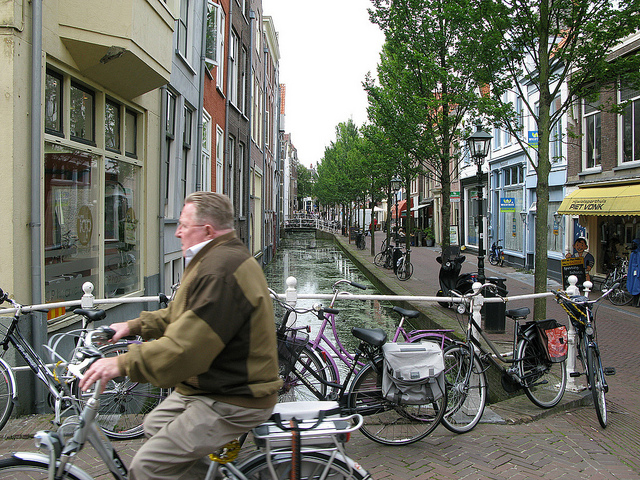
Delft: cyclists, Vermeer, and pottery
Mrs Taylor and me didn't want this to be a major event; just an easy cycle ride with places to see. We haven't cycled in Holland before but we knew it was flat with plenty of history, so it seemed a good choice. The plan was a circular route of about 450 miles over nine days: a cycle tour beginning and ending at the mighty Europoort near Rotterdam.
We sailed Hull-Rotterdam overnight with P&0 Ferries and left our car at Chris Bailey's house not far from the port - thanks to Chris and Mrs Bailey. Meeting Chris made a pleasant start to our trip. You arrive at Europoort in the early morning as the boat sails in down one of the many channels that make up the huge estuary of the Dutch rivers Lek and Waal, which upriver are actually the Rhein before it splits east of Nijmegen. The river Maas is in there somewhere too.
All this water is a foretaste - be ready for a lot of canals, wet fields and little ditches running everywhere with a flat green surface like pea soup. The Amsterdam region is mostly below sea level and if that's where you're heading you cycle east from Europoort along the river to the ferry crossing at Maassluis. By mid-morning we were in Delft, a pretty town famous for Delftware pottery and the Rennaisance painter Vermeer. In Delft there is also a church whose tower leans more than the one at Pisa.
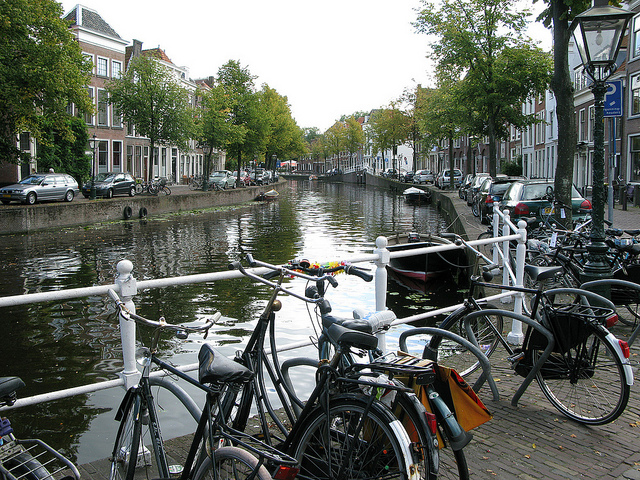
Leiden, birthplace of Rembrandt
There was no need for maps because our route for each day was pre-loaded on my Garmin GPS along with a waypoint for each B&B we'd booked in advance. The routes delivered us into the various town centres, then to find the B&B I brought up its waypoint and did a "Go To" which navigated to the front door.
Anyhow, we made our way to the North Sea coast at Scheveningen where the promenade is a Dutch version of Brighton, or even Blackpool. From there the Garmin took us to the Den Haag home of Friedel and Andrew who'd kindly offered to put us up for our first night in Holland. Also staying was a young Canadian cycle tourist called Jeff. A big thanks to our hosts (and I haven't forgotten to send Friedel my copy of 'I Follow the Wind' by Louise Sutherland - Friedel is researching the history of cycle touring for a book).
We changed our plans slightly on day two: the ride up to Haarlem in the tulip-growing region. Instead of cycling from Den Haag all the way up the coast along the famous North Sea Cycle Route we first went inland to Leiden (also Leyden), birthplace of Rembrandt. In the afternoon we cycled up to the coast - literally up, as the landmass here is below sea level - and north along a path by the dunes.
The sea is not visible from this long and featureless path. To see it you make your way to the beach over the main dune that protects the land.
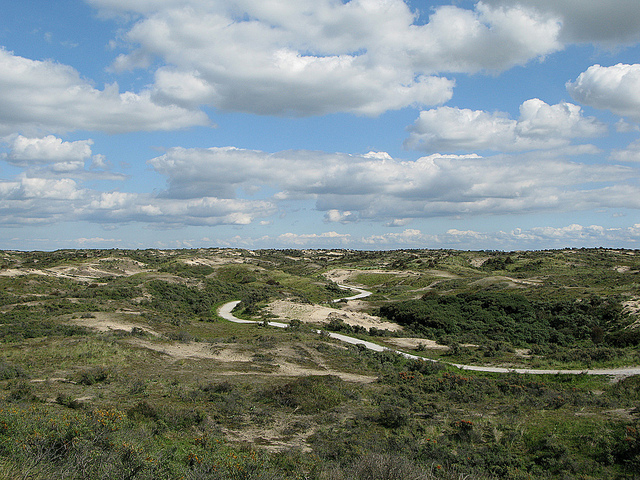
Nature reserve in the dunes near Zandvoort
At Zandvoort, where the Formula One Dutch Grand Prix was held for several decades, we turned inland to Haarlem and navigated to our B&B located right in the centre of town. The entire population was slaughtered by the Spanish in 16th Century but this was followed by a golden age of culture and prosperity. Both Handel and Mozart (aged 10) played the organ in Haarlem's cathedral.
This B&B had a tiny courtyard at the rear so instead of dining out we bought ready-to-eat salads and beer at Albert Heijn, a Dutch a supermarket chain founded in 1887. This is not quite as old as Sainsbury's in the UK, founded in 1869. Holland is much cheaper than Denmark. Our evening meal cost less than 10 Euros and this suggests an approach where you spend more on accommodation (upmarket B&Bs in Holland are superb) and less on food by dining in. You can always sit out in the square with a beer.
Like all of the towns we visited, Haarlem has pretty canals in abundance. They're a cliché perhaps, but they're real. So are the cyclists. The universal use of the bicycle as a means of personal transport in Holland, even if you've heard about it beforehand, is quite breathtaking to see and be part of. People on bicycles are literally everywhere and bikes are piled up on every street corner, every facade, down every alleyway. Abandoned bicycles can be seen on grass verges and in the little pea soup waterway ditches that criss-cross throughout the land.
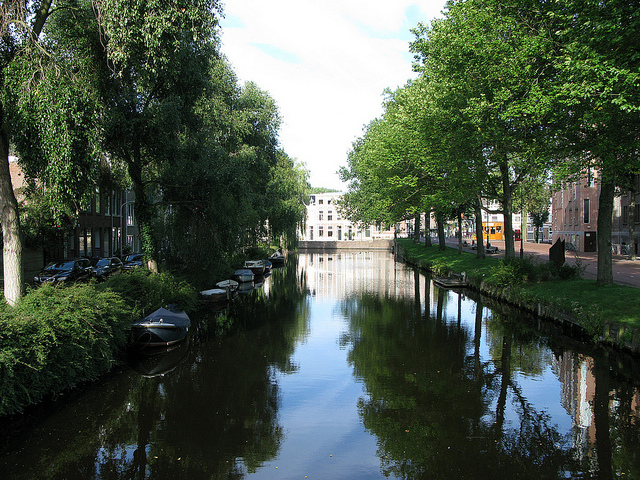
Canal, Haarlem
Day three: to Hoorn via Edam. From Haarlem, close to the North Sea, we cycled eastwards across NoordHolland to Edam on the opposite coast. This is not really a coast but the banks of the Markermeer, a huge man-made lake that together with the Ijsselmeer forms the largest lake in Northern Europe (technically a reservoir). This tract of water is associated with the better known Zuiderzee which was once an unstable inlet of open sea, prone to disastrous flooding. In 1932 a 30 kilometre long dyke - the Afsluitdijk - was built to enclose it and the resulting 'lake', fed by the River Ijssel, gradually turned seawater into fresh, with a water level higher than the adjacent Wadden Sea. If you stand on top of the Afsluitdijk you can see how the lake is higher and the water green, compared to the blue of the sea a few tens of metres away.
This was a Sunday and the cycle paths were full of families out on their bikes, enjoying the fine weather, as we did. More dykes, more waterways, windmills and big open skies. Edam is as picturesque as you'd expect. Hoorn too, with a pretty harbour that in the Medieval age was home to a mighty merchant fleet. Cape Horn, incidentally, is named after the town - a reminder that the Dutch, along with the British, once ruled the world's oceans.
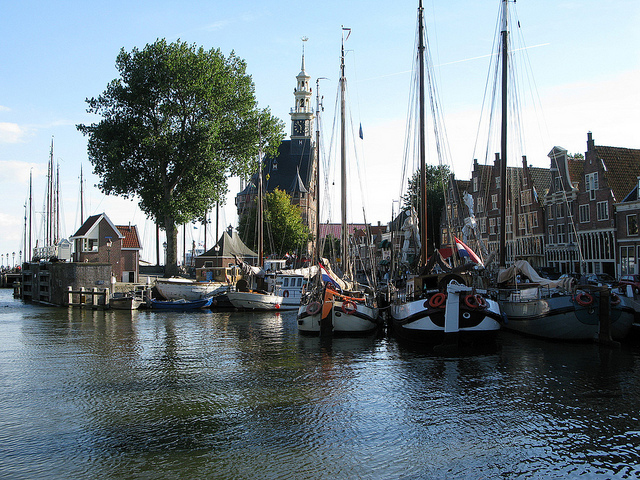
The harbour at Hoorn
Our B&B at Hoorn was run by Hans as part of his house, located on an estate a mile or so from the centre. He promised one of his famous Dutch breakfasts for the morning, then we rode into town and dined outside at a pleasant waterfront restaurant. The next day (the breakfast was everything he'd promised) Hans told us this would be the last day of summer and to expect stronger winds from the east. This day - day four - was our eastward crossing of the 30 kilometre long Afsluitdijk and 62 miles in total, but we casually brushed off the wind news. After all, Holland is flat.
For the record: our B&B accommodation in Holland:
Tussen de Lakens, Wietzke van Oene, Lange Lakenstraat 17, 2011ZB Haarlem
Tel: 0235 321521 / 0621 591002
c/o Hans van der Heiligenberg, Koperslager 67, 1625al Hoorn
Tel: 0229 242682 / 0646 468702
De Alde Smidse, c/o Coby Dijkstra, Noardein 93, Oppenhuizen
Tel: 0623 360779 / 0515 559678
B&B Polderpoort, c/o Mrs Schouten, Henk Steenbeekhof 33, 8264BZ Kampen
Tel: 0623 026590
J.A. Van Zanten, Groenestraat 12, Deventer (budget accommodation)
Tel: 0570 615249
De Lentehof, Laauwikstraat 22, 6663CK Nijmegen
Tel: 0653 539439 / 0243 601024
A.J. Besseling, Sumatrastraat 65-67, Dordrecht (budget accommodation)
Tel: 0630 543513 / 0786 148364
Hoorn to Deventer
From Hoorn we set off cycling northwards the 20 miles to the western end of the Afsluitdijk where we'd turn north east to make the 18-mile crossing. I stopped to photograph some gorgeous traditional paving on the surface of a country road.

A beautifully paved road, but not too comfortable to cycle on
At the end of this road we turned left past a house, then along a cycle path with open fields on each side. Just as we'd got going I heard a loud crack behind me then a shout from Sandra. I turned to see her on the ground, lying with her bike on its side. This is a sight you never want to see: your cycling partner flat out after a tumble, not to mention your actual wife. I stopped and ran back, thinking: "She's badly hurt. This trip is finished." It could have been. We didn't know then, but she'd badly dislocated her left shoulder blade and broken two ribs.
There are two heavy bollards at the start of the path. One is in the grass at each side. In the centre is another collapsible bollard painted red and white. As she'd entered the path Sandra had been looking sideways at some horses in the field and ridden into the central bollard, knocking her left front brake clean off the fork and denting a pedal. Then she and her bike came crashing down, the left side of her chest falling on the handlebars. It was several minutes before she could get up again and she was in pain all over her left side.
A woman from the nearby house came over and asked if we were ok. Sandra was standing up by this time, but looking shaken. We asked for directions to the nearest town. Medemblik, she said, and there's a bike repair shop there. We cycled slowly over the bumpy cobbles, Sandra with no front brakes and feeling groggy. Sure enough, we came to the bike shop on the way into town: Leo Smit at www.twc-leosmit.nl.
We've nothing but praise for the helpful and friendly people who work in the Leo Smit bike shop in Medemblik. An expert mechanic repaired Sandra's brakes there and then for 10 Euros. Obviously the best bike shop in Holland!
Now we had a decision to make. We'd been headed north towards the 18-mile long dam leading to the far side of the Ijsselmeer, but at Enkhuizen a little down the coast in the opposite direction is a ferry across the Ijsselmeer. To continue our trip we needed to get across to Sneek that night. The bike shop mechanics reckoned it made more sense to stick to our original route, especially as there's only one daily ferry crossing (or perhaps two) from Enkhuizen. So off we went, northwards again, protected from the strong east crosswind by a dyke.
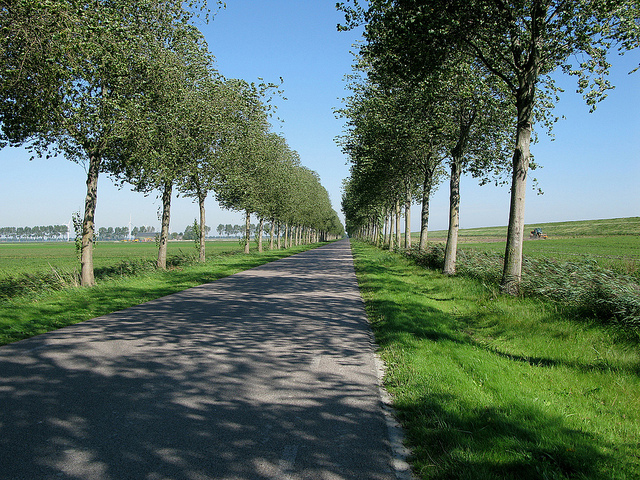
The Ijsselmeer is just over the dyke on the right
At the western end of the Afsluitdijk we turned east into the wind and set out across it. You cannot see the other end, 18 miles away. I really wanted to cycle this route and I think it was partly this that encouraged Sandra along. Partway over I crossed a footbridge over the main highway to get us some coffee and cake. Then we ploughed on again with the stiff crosswind now at an angle of 2 o'clock. The few cyclists we met going the other way seemed to fly along. Not us, and each time a truck went by in the other direction an extra gust of wind hit like a closing door.
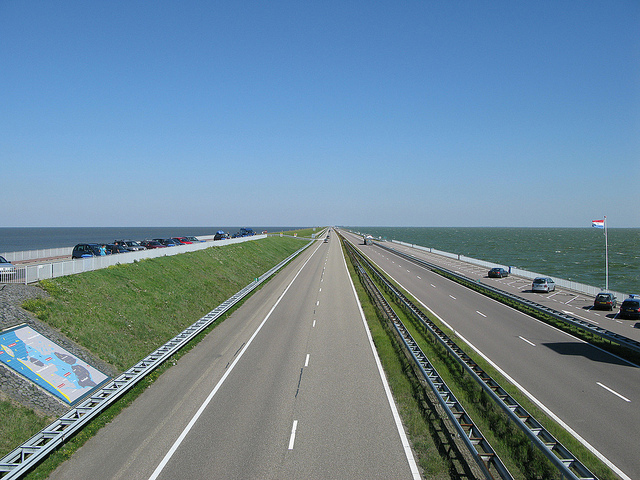
Partway across the Afsluitdijk
At the eastern end we turned south east directly into the wind and zig-zagged along lots of country roads until it was time to phone the B&B to say we'd be late. Oppenhuizen was still maybe 10 kilometres away. Coby, the landlady, immediately offered to send her husband to pick us up in his friend's van - an act of kindness and generosity which we gratefully accepted. The Dutch are surely the friendliest people you could hope to meet anywhere.
We thought of abandoning our tour that night†. We didn't know whether Sandra was badly injured or not. She was certainly in pain, but the next morning - day five - we'd see how she went and set off in heavy rain to Kampen over 50 miles away. After a couple of hours we were wet and cold and stopped in a bus shelter to warm up. A bit further on at Macdonald's the manageress came out with complimentary cappuchinos. Cheeseburgers and chips turned things around and we arrived at the superb B&B in Kampen in good shape considering everything.
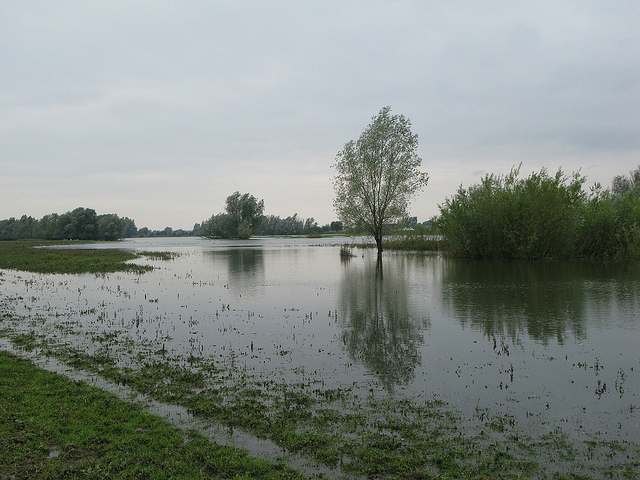
Wetlands between the dykes
Day six to Deventer was damp but not raining hard and the wind had dropped. Pleasant cycling in a brooding landscape under a hard grey sky, and all rather beautiful. Sandra was still okay but when we came into town we happened to stop near a medical centre so we went to get her seen by a doctor. She'd dislocated her shoulder blade he said, and as the next two days were 64 and 67 miles we'd go by train. It meant we'd also get to see something of Nijmegen on day seven, including the National Bicycle Museum.
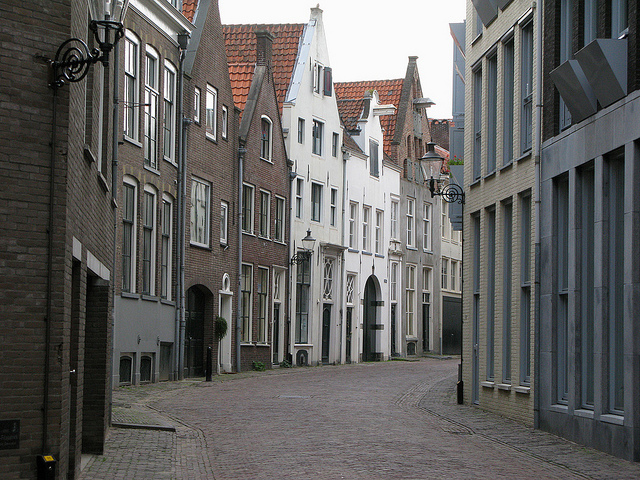
Street in Deventer - the facades on the left really do lean forward
Our B&B in Deventer was okay and good value for about £16 each including breakfast. The room was up an attic ladder but peaceful and our hosts were pleasant enough. Kampen and Deventer are both lovely towns with the usual canals but also the River Ijssel meandering its way up north to the Ijsselmeer. We'd have liked more time to look around but that applies to all the places we visited in Holland. Next time maybe.
We had Snowcard travel insurance with bike repatriation but this isn't as simple as it might seem. We could have flown home quite easily but didn't fancy someone transporting our bikes, and Sandra couldn't have carried anything.
Deventer to Rotterdam
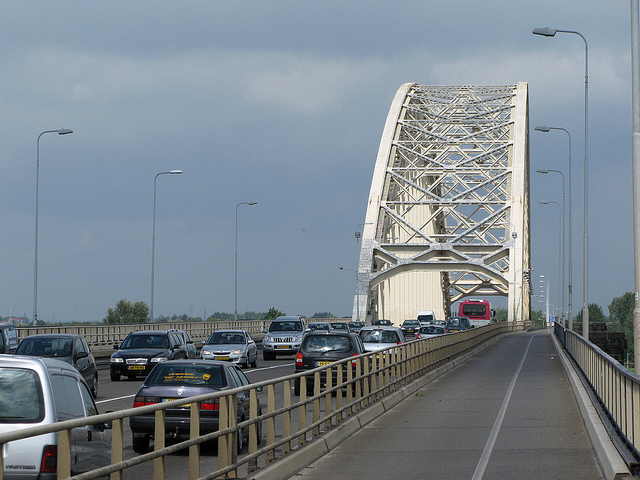
The Nijmegen road bridge
From Nijmegen station we cycled to a park and phoned our next B&B to ask if we could leave our panniers there while we spent the day in the town. Tom said fine and my Garmin led us over the bridge to his place on the north bank of the River Waal. Then we cycled back over. My father helped defend the Nijmegen bridge in 1944 as part of the Allied Advance into Germany. Read more on page 8 of his war diary, also page 9.
The National Bicycle Museum is interesting enough, with lots of old bicycles with wooden wheels and an even older one invented by Leonardo da Vinci. Unfortunately for Nijmegen the town was flattened during WW2, as was Arnhem a little to the north. The town that was used in 'A Bridge Too Far' was actually Deventer, as it still had some old buildings left standing. There are very few nice buildings in Nijmegen but Tom's B&B was superb and he was a charming host. He was especially proud of the Dutch breakfast he served us, which in fact was pretty much the same idea as a Danish or German breakfast. Very nice. In the evening, Albert Heijn ready-to-eat salads and reading books.
We travelled to Dordrecht on the train - day eight. This is one of several towns that claims to be the oldest in Holland (1220). As in Deventer we were staying in a B&B selected from our Vrienden op de Fiets book 2010 and which never cost more than 18.5 Euros per person. So it was up in the attic again but this house had kitchen and living/dining on the middle floor - and other guests.
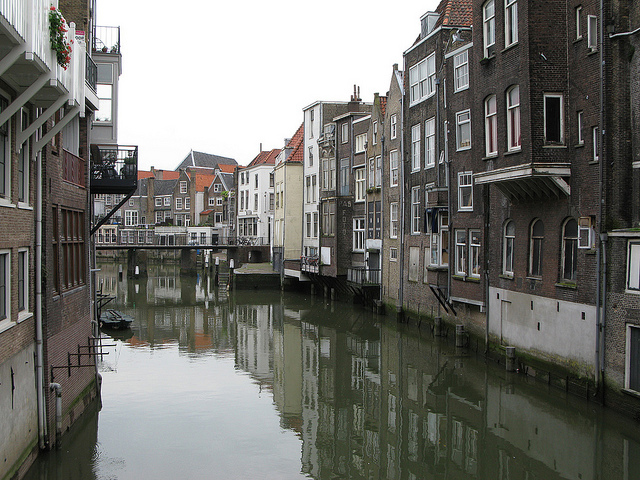
Canal, Dordrecht
Friedel, whom we'd stayed with in Den Haag on our first night, had recommended the Waterbus from Dordrecht to Rotterdam, so we cycled along to the jetty to suss it out for the next day. There's no train from Dordrecht to Europoort so the Waterbus would save us several miles. Waiting at the jetty for the rain to stop were a couple of British cycle tourists distinguishable by their Dawes/Thorn bikes and Carradice bags. We had a quick chat. They were about to set off to their hotel, which they were looking forward to because it had a swimming pool. As we looked around the town's various canals we wondered which establishment was theirs. We ate some burgers at Macdonald's.
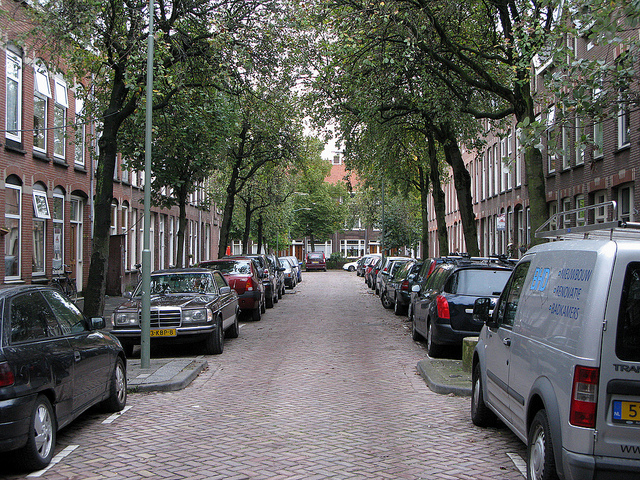
Our pleasant B&B in Dordrecht was in this street on the right hand side
Dordrecht is another of those pretty Dutch towns on the water and it was by water that we left the following morning. On the way to the Waterbus I noticed my Garmin showed our altitude as minus 35 feet. Our last day in Holland was bright and sunny and we arrived in Rotterdam ready for a pleasant few miles cycling west up the river to the Maassluis crossing and then to Europoort.
The Garmin began to lead us north through Rotterdam, towards the freeway I guessed, so I reset it to pretend it was a bicycle instead of a delivery van and we retraced our path slightly until we were back en route to Maassluis. Urban cycle paths in Holland are often block-paved and the wheel vibration was uncomfortable for Sandra with her injured chest and shoulders. There wasn't much we could do about it except press on and hope for tarmac. In the event, the riverside path was mostly nice and smooth, and after apple pie and coffee at Maassluis we were soon on the boat.
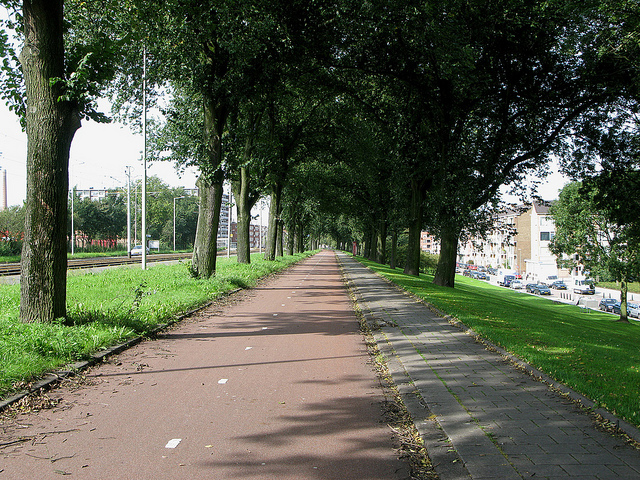
Dyke path to Maassluis - the land on the right is lower than the river (to the left)
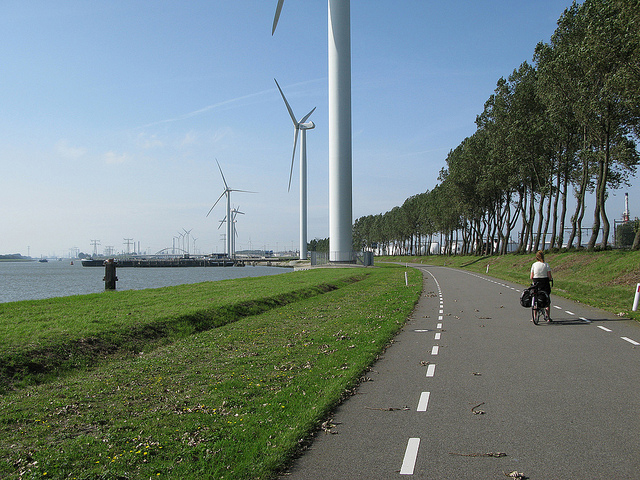
The cyclist's windy approach to Europoort
On websites like Amsterdamize and Copenhagenize you read how mass cycling can be achieved anywhere, including the UK, if only there is enlightenment and a public and political will to make it happen. This is nonsense. Dutch-style mass cycling and the infrastructure that goes with it will never happen in the UK. Holland is flat, the UK is not.
See also Cycling Holland: light, wind and water »
Articles »